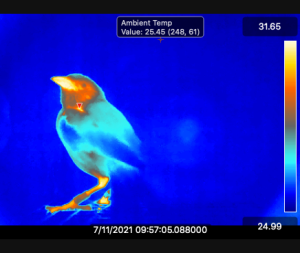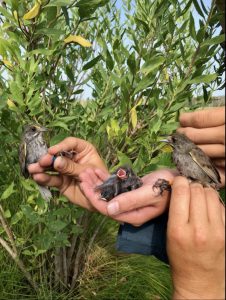
Climate Change Adaptation: The Bill Morphology of Tidal Marsh Sparrows Through Thermography
By Stefania Irene Marthakis and Mackenzie Roeder
Saltmarshes (a.k.a. tidal marshes) are one of the most productive eco-systems on earth. As protectors of coastal landscapes and communities—that absorb flood waters as well as carbon—saltmarshes can also provide insight into climate change adaptation. Among this dynamic habitat that is full of bugs, not a lot of predators, and plenty of places to nest, you will find the Seaside Sparrow, Saltmarsh Sparrow, and Nelson’s Sparrow — each representing a different colonization from 2 million years ago, half-a-million years ago, and 5,000 years ago, respectively.
Mackenzie Roeder, a Ph.D. candidate in Ecology & Environmental Sciences at the University of Maine, studies genome-to-phenome linkages in tidal marsh adaptation, specifically from the unique perspective of the bill morphology of Seaside, Saltmarsh, and Nelson’s Sparrows. As part of the NSF EPSCoR RII Track-2 grant, GECO (Genomic Ecology of Coastal Organisms: A Systems-Based Research and Training Program in Genome-Phenome Relationships in the Wild), Roeder brings a comprehensive approach to understanding this phenotype (this trait).
The sparrow’s bill, with its large surface area—as compared to non-tidal sparrows—is the main tool it uses to interact with the environment. According to Allen’s rule, warm climate-adapted animals have larger appendages than cold climate-adapted animals, which allows them to maximize or minimize heat loss, respectively. A corollary to Allen’s rule known as the Greenburg-Tattersall Corollary suggests this pattern is also true along saline gradients. Roeder investigates whether larger bill size of these sparrows allows for increased levels of radiative heat loss rather than evaporative heat loss (which conserves water). This is especially critical in saltmarshes where freshwater is limited.
“This is a newly understood phenomenon in general,” Roeder stated, “so it’s not understood how common this is across avian taxa yet.”
The bill of the bird—like the legs—is filled with blood vessels. Because heat flows from areas of high temperature to areas of low temperature, Roeder hypothesizes that if blood flow is increased to these areas, which raises the sparrow’s body surface temperature (relative to ambient temperature), this allows the sparrow to lower its core body temperature without evaporation (i.e., no freshwater loss) as heat flows from the warm bill to the cooler air around it.
“These three birds represent independent colonization events of tidal saltmarsh habitat,” Roeder stated,” and, potentially, a degree of specialization to this habitat correlated with the time since colonization, which we refer to as an adaptive gradient. If these birds do phenotypically represent an adaptive gradient, then we would firstly anticipate that they would use their bills to dissipated heat—to some extent at a minimum—probably to a greater extent than other non-tidal taxa, and that this bill ‘use’ would increase proportionally with the time since colonization.”
Roeder further explained, “This means we anticipate that Seaside Sparrows, who colonized first and have the largest bills, would use their bills more-so in a thermoregulatory capacity than Saltmarsh and Nelson’s Sparrows, suggesting that their thermoregulatory strategies may be optimized to reduce freshwater loss.”

Thermography (the use of thermal imaging cameras to monitor changes in heat patterns and blood flow) of wild animals can be complicated in a laboratory setting, because it requires capturing live animals and housing them for extended periods of time. To address this challenge, Roeder has built a portable temperature-controlled thermal chamber (electrical cooler box) that allows her to capture birds in tidal marshes and place them within the box in a safe and calm (dark) environment. Here the birds experience the same thermal gradient (a range from 10°C – 35°C), over the course of one hour while being monitored with a thermal imaging camera, before they are released back into the marsh. Roeder explained, “This standardized gradient exposure is essential for comparing the bird’s physiological responses and mimics a common range of temperatures experienced by the birds during the breeding season.”

Currently, Roeder is focused on thermography as part of her summer 2022 work in Maine, New Hampshire, and New Jersey. With the thermal chamber, Roeder can see what the sparrows do physiologically as the temperature increases. Already, these three sparrows are exhibiting different physiological behaviors.
Roeder’s research has shown “Seaside Sparrows regularly dissipating 20% of their overall radiative heat from their bill. As temperatures increase beyond 25°C, Seaside Sparrows have increased blood flow to the bill such that 50-60% of all heat lost from the bird is from its bill, which is phenomenal!”
Next, Roeder compares her early results with other researchers’ work on Song Sparrows along salient gradients, which inspired her current work. Though the methods are different, their results showed that tidally adapted Song Sparrows dissipated more heat from their bills than non-tidally adapted ones, and that the maximum percentage of total heat loss from the bill of these sparrows was ~15%, with an average of 10%. The much larger percentage of overall heat loss in these tidal marsh obligate birds is exactly what Roeder and her team would expect following our adaptive gradient hypothesis.
Since physiology is a behavior that is affected by the environment, Roeder contemplates whether she is capturing some local phenomenon of climatic acclimation. To address this question, she replicated sites for each species along a natural thermal gradient (from New Jersey to the north-eastern tip of Maine) during the breeding season. She repeated this work on their wintering grounds, where all three species co-occur in the same marshes and are adapted to the same climate.

This led Roeder to ask these critical, comparative questions: “Is the use of the bill, as a thermal window, to lose heat associated with their colonization order? Can we use this system to test hypotheses on the way evolution shapes traits—and helps in adaptation? And finally — what else is affected by this increase in bill size? Does this morphological difference affect their fitness? Does a larger bill mean they’re better able to dissipate heat and compete for mates and territories, does it increase their ability to forage and provide food for their young when it’s hot, does it affect their ability to sing and attract mates?”
Roeder and the GECO team run demographic sites where they monitor the breeding activity of these birds. By finding their nests, monitoring their success, conducting paternity analyses, and monitoring the growth rates of their chicks, they can determine levels of fitness (individual male reproductive success) that they can compare with bill morphology to look for correlations. She is also conducting research studying the songs the males sing to determine if bill morphology impacts song production, and in-turn if abiotic forces (e.g., heat) impact their song quality.
“These ideas are all interconnected and an attempt to comprehensively view the bill and the ways in which it is important to the birds,” Roeder explained. “Finally, I will be using genetic data collected from these birds to determine the heritability (the level of variation in the trait that is due to variation in the genes) of bill morphology and will be conducting a genome-wide association study (GWAS) linking regions of the genome to bill size differences.”
While Roeder studies tidal saltmarsh birds , her thermoregulation research has broad implications for all kinds of taxa, even freshwater-limited environments such as arid habitats and high mountain habitats. And applicable questions on whether the role of a phenotype in thermoregulation, in this case the bill, is different between species, within individuals, and at the level of within-population genomic variation, which can lead to further genome-to-phenome linkages in the study of climate adaptation.
“This is a newer phenomenon to us,” Roeder stated, “a newer way of understanding the trait that is the bill. For a long time, people have just studied it as the way the bird gets food. Thinking of this trait as an integral part of a whole body, not a separate part of the bird, is important. It is the bird. And it takes part in all the things the bird does, so we must understand it from more than one context.”
